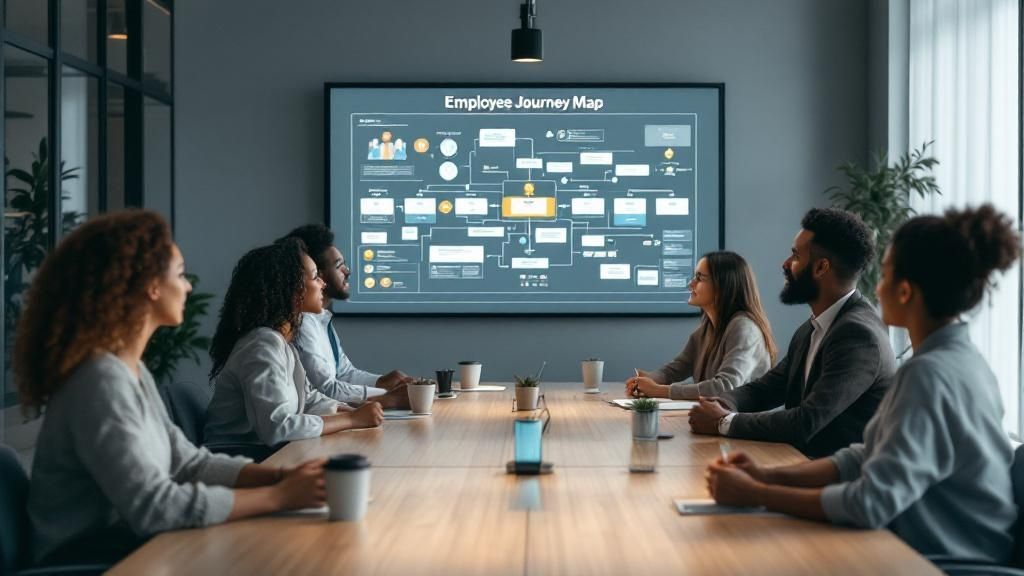Understanding What Employee Journey Mapping Really Means

Employee journey mapping is more than just a popular HR term; it's a valuable method for understanding and enhancing the entire employee lifecycle. Think of it as designing a roadmap of the experiences your employees have, from their first encounter with your company to their eventual departure. This allows you to see your organization through their eyes.
This means understanding not only what occurs at each interaction point, but also how it affects them emotionally.
Why Is Employee Journey Mapping Important?
This method is particularly important in today's ever-changing work environment. With shifting employee expectations and the rise of remote and hybrid work, understanding the employee journey is more crucial than ever. Imagine, for instance, a new remote employee struggling to access necessary software or connect with their team.
These seemingly minor issues can quickly become major problems affecting productivity and job satisfaction.
Employee journey mapping has also gained importance as companies strive to boost productivity and efficiency while maintaining employee satisfaction. This process helps HR departments visualize and analyze every interaction employees have with the company, identifying areas for improvement and potential obstacles. Learn more about employee experience journey mapping.
Key Stages in the Employee Journey
While every organization is different, most employee journeys share some common stages. Effectively mapping these stages involves carefully examining the touchpoints within each and assessing their impact on the employee.
- Hiring: This stage starts with the initial job posting and continues through the interview process. A complicated application or a negative interview experience can discourage top candidates.
- Onboarding: First impressions are crucial. A smooth, well-organized onboarding experience sets the foundation for long-term success.
- Development: This stage centers on continuous learning and growth, including performance reviews, training opportunities, and career advancement.
- Engagement and Retention: This involves fostering a positive work environment where employees feel valued, supported, and motivated. Using AI to Tackle the Workplace Mental Health Crisis.
- Offboarding: Even when employees leave, a well-handled offboarding process can safeguard your company's reputation and nurture important relationships.
By meticulously mapping these stages, organizations can pinpoint areas for improvement and cultivate a more positive and productive work environment. This ultimately results in increased employee satisfaction, improved retention rates, and a stronger overall performance.
Spotting The Hidden Friction Points That Matter Most
Every organization faces hidden friction points. These subtle barriers can significantly impact employee satisfaction, engagement, and ultimately, performance. Identifying and addressing these issues is crucial for a thriving workplace. Employee journey mapping is an invaluable tool in this process.
Identifying Pain Points Through Employee Journey Mapping
Employee journey mapping allows HR teams to visualize the entire employee lifecycle, from recruitment to exit interviews. By carefully examining each stage, organizations can uncover hidden frustrations that affect retention and engagement. A cumbersome onboarding process, for instance, can leave new hires feeling overwhelmed. A lack of clear career development paths can lead to disengagement among existing employees.
Understanding employee needs and pain points throughout the lifecycle is essential. Consider that only 12% of employees strongly believe their company excelled during onboarding. Furthermore, just 25% of hybrid and remote knowledge workers feel connected to their organization's culture. Learn more at How Journey Maps Can Optimize the Employee Experience.
Distinguishing Between Minor Inconveniences and Systemic Issues
Not every friction point is equally important. Some are minor inconveniences; others signify larger systemic issues requiring immediate action. The key is distinguishing between the two. This involves analyzing behavioral patterns, like increased absenteeism or decreased productivity. Recognizing early warning signs of disengagement, such as decreased participation in team activities, is also important.
For example, if employees consistently struggle to access information or resources, it might indicate a problem with internal communication systems. Addressing this underlying issue is more effective than providing individual workarounds.
Prioritizing the Right Friction Points
Effective employee journey mapping helps prioritize friction points. It's easy to focus on obvious problems, but these may not have the biggest impact. Sometimes, small issues, like a lack of recognition or a confusing performance review process, can significantly affect employee morale and motivation.
By analyzing data from surveys, interviews, and other feedback, organizations can identify the truly important friction points. This targeted approach maximizes the impact of HR initiatives and ensures resources are used effectively. Developing specific solutions to address these key issues leads to more meaningful improvements in the employee experience.
Building Journey Maps That Drive Real Change

Creating effective employee journey maps requires a thoughtful, structured approach. It's about truly understanding the nuances of today's workplace experience, not simply checking off items on a list. This involves several key phases that successful organizations employ, from initial stakeholder alignment and data collection to developing detailed personas and pinpointing crucial interaction points.
Aligning Stakeholders and Gathering Data
First, it's essential to ensure everyone is working towards a common goal. This means aligning stakeholders across different departments—Human Resources (HR), management, and the employees themselves—on the objectives of the employee journey mapping initiative. This shared understanding is crucial for creating a map that accurately reflects the organization’s needs and priorities. It also helps ensure buy-in for any changes that result from the mapping process.
Next, the focus shifts to data collection. Gathering both quantitative data (numerical data) and qualitative data (descriptive data) is vital for a complete understanding of the employee experience. Surveys, interviews, and focus groups offer valuable insights into employee perceptions and emotions. Analyzing existing HR data, such as performance reviews and turnover rates, adds another layer of understanding. Combining these perspectives provides a comprehensive view of the employee journey.
Developing Personas and Identifying Touchpoints
With the necessary data gathered, the next phase involves developing employee personas. These represent typical employees at various stages of their journey within the company, enabling a more focused and personalized mapping approach. For example, a new hire persona might highlight anxieties related to onboarding and integrating into the company culture. In contrast, a senior employee persona might focus on career growth and development opportunities.
Identifying touchpoints is another critical element of this process. These represent all the interactions an employee has with the organization, from the initial job application to their eventual departure from the company. Each touchpoint, positive or negative, contributes to the overall employee experience. Understanding these touchpoints helps identify areas for improvement and opportunities to foster more positive interactions.
Balancing Metrics and Emotional Insights
Effective employee journey mapping requires a balance of hard metrics and emotional insights. While metrics like employee turnover and productivity are important, they only tell part of the story. Understanding the emotional aspects of the employee experience is equally important. This means capturing how employees feel at each touchpoint. Are they enthusiastic, frustrated, or indifferent?
For instance, a high turnover rate might initially point to issues with compensation or benefits. However, a deeper dive into the emotional insights might reveal that a lack of recognition or limited development opportunities are the true source of dissatisfaction. This nuanced understanding leads to more effective and targeted interventions. Focusing on both the measurable and the human aspects of the employee experience ensures that employee journey mapping translates into real, actionable improvements, creating a workplace where employees thrive and perform their best work.
Using Data To Uncover What Surveys Miss
Modern employee journey mapping goes beyond annual surveys and focus groups. It requires in-depth data analysis to reveal hidden patterns that influence engagement and retention. Leading organizations are now combining traditional feedback with advanced analytics for a deeper understanding of employee behavior and satisfaction.
This means moving beyond simply asking employees how they feel and delving into the why behind their responses. For example, high turnover rates might typically indicate dissatisfaction with compensation.
However, data analysis might reveal a correlation between departures and a lack of development opportunities or limited internal mobility. This allows HR to address the root cause, not just the symptom.
Leveraging Technology for Deeper Insights
Emerging technologies and platforms now enable real-time journey tracking. This offers a dynamic view of the employee experience, capturing fluctuations in sentiment and identifying emerging trends as they happen. Predictive modeling takes this a step further, using historical data to anticipate future behavior and potential challenges before they escalate.
This allows for proactive interventions and personalized experience optimization. You might be interested in: Top Employee Feedback Tools for 2025.
Practical Applications of Data Analysis
Identifying trends is just the beginning. Measuring the impact of these trends on key metrics like productivity, retention, and even customer satisfaction is crucial. This allows HR to demonstrate the ROI of employee experience initiatives and make a strong case for continued investment.
In recent years, there has been a significant focus on improving employee experience, with 71% of employees globally being engaged in their work according to a 2025 survey. By regularly surveying employees and analyzing data through people operations platforms, companies can identify trends and optimize their strategies to align with both employee and organizational goals.
Data should also be used to continuously refine your employee experience strategies. This creates a feedback loop where insights lead to action, which generates more data for further refinement.
From Reactive to Proactive HR
Successful companies are transitioning from reactive HR management to proactive experience design. This means anticipating employee needs and addressing potential problems before they even arise. By analyzing patterns in data, HR can identify potential friction points and develop solutions that enhance the employee journey at every stage.
This shift empowers organizations to create a workplace where employees not only feel satisfied but also thrive. This proactive approach leads to a more positive, engaging, and ultimately, more productive work environment. Combining this approach with powerful tools like Happily.ai ensures a more data-driven and effective approach to managing the employee lifecycle.
Turning Insights Into Improvements That Stick
The real power of employee journey mapping lies in transforming discoveries into positive changes with tangible impact. This goes beyond simply identifying pain points. It means implementing solutions that truly resonate with your employees. This section focuses on translating analysis into action, providing frameworks for prioritizing initiatives and securing buy-in across the organization.
Prioritizing Initiatives and Securing Buy-In
Understanding employee sentiment requires incorporating both quantitative and qualitative data. Similar approaches are used to analyze customer behavior, as discussed in this article about Qualitative and Quantitative Research. After pinpointing key friction points in your employee journey map, prioritize which issues to tackle first. Consider factors like the problem's severity, the number of employees affected, and the resources needed for implementation.
Securing buy-in from key stakeholders is essential. Present a compelling business case for employee experience investments, outlining the potential benefits of addressing specific pain points. These benefits often include improved retention and increased productivity. A shared understanding ensures everyone is aligned and working toward common goals.
To further illustrate how to prioritize improvements based on different factors, let's examine the following table:
Employee Journey Mapping Implementation Priorities
A comparison of high-impact improvements across different employee lifecycle stages with implementation difficulty and expected ROI
| Lifecycle Stage | Priority Improvement | Implementation Difficulty | Expected ROI | Timeline |
|---|---|---|---|---|
| Onboarding | Streamlined paperwork process | Low | High | 1 month |
| Training | Personalized learning modules | Medium | High | 3 months |
| Performance Management | Regular feedback system | Medium | Medium | 6 months |
| Offboarding | Exit interview process improvement | Low | Medium | 2 months |
This table highlights the importance of considering implementation difficulty, expected ROI, and timeline when prioritizing improvements. Quick wins with high impact, like streamlining onboarding, can be tackled first. More complex initiatives can be planned for later stages.
Implementing Changes and Creating Lasting Impact
Executing changes that resonate with your workforce is vital. This often means going beyond quick fixes and implementing systemic changes that address the root causes of dissatisfaction. For instance, if onboarding is a major pain point, redesigning the entire process, rather than just tweaking individual steps, might be necessary. For more insights on gathering feedback, you might find this helpful: Creating a Feedback Culture in Your Workplace.
Focus on creating lasting improvements. This means implementing solutions that are not only effective but also sustainable. This might involve developing new policies, investing in new technologies, or creating ongoing training programs.
Maintaining Momentum and Avoiding Pitfalls
Maintaining momentum throughout the improvement process is critical. Set clear timelines, track progress regularly, and celebrate successes along the way. Consistently collecting employee feedback during and after implementation is crucial to ensure that changes are effective and address the intended issues. Tools like Happily.ai can facilitate this feedback loop.
Be prepared to adapt and adjust your approach. The employee experience is constantly evolving, so your journey map and improvement initiatives should evolve too. This continuous optimization is essential for a workplace where employees feel valued and supported.
Measuring Success And Keeping The Momentum Going

Effective employee journey mapping is more than a one-off project. It's a continuous process that requires regular check-ins and adjustments to truly make a difference. Like any successful initiative, tracking progress, analyzing the results, and adapting your approach to your workforce’s evolving needs is crucial.
Establishing Meaningful KPIs
Measuring the success of your employee journey mapping starts with defining relevant Key Performance Indicators (KPIs). These KPIs should reflect your organization's overall goals and accurately represent the different aspects of employee satisfaction. While standard metrics like employee turnover rates and employee satisfaction scores provide a good foundation, they may not capture the subtle shifts in employee sentiment and behavior.
These small changes can often indicate bigger underlying issues. For instance, a small rise in employee absenteeism, coupled with a dip in team activity participation, could point to growing disengagement.
Advanced Measurement Techniques
Beyond traditional metrics, consider incorporating more advanced tools. Pulse surveys offer regular insights into employee sentiment, allowing you to monitor changes over time. Analyzing data from internal communication platforms like Slack can uncover communication and collaboration trends. This helps you understand the impact of initiatives designed to boost teamwork.
Creating Feedback Loops
Feedback loops are vital for continuous improvement. Actively seeking feedback from employees at every stage, and then using that feedback to adjust your map and strategies, is key. Platforms like Happily.ai can simplify this process by providing tools for gathering and analyzing employee feedback. This data-driven approach ensures your employee journey map stays relevant and effective. For more insights, explore our guide on Employee Engagement and Employee Turnover: A Study.
Building a Culture of Ongoing Optimization
Leading organizations prioritize a culture of continuous improvement. They recognize that the employee experience is dynamic and requires ongoing attention. This involves regular reviews and updates to their employee journey map, integrating new data and insights as they emerge.
This commitment ensures their initiatives stay effective and responsive to the ever-changing needs of their employees. To better illustrate these metrics, take a look at the following table:
To understand how we can measure the effectiveness of these initiatives, let's look at some key metrics across different timeframes. The following table outlines how you can measure the impact of your efforts.
Employee Journey Mapping Success Metrics
Key performance indicators for measuring the effectiveness of employee journey mapping initiatives across different time horizons
| Metric Category | Short-term (0-6 months) | Medium-term (6-18 months) | Long-term (18+ months) | Measurement Method |
|---|---|---|---|---|
| Engagement | Pulse survey scores | Employee Net Promoter Score (eNPS) | Retention rate | Surveys, feedback platforms |
| Onboarding | Time to productivity | 3-month retention | Performance in first year | HR data, performance reviews |
| Development | Training completion rates | Skill development | Promotion rates | Learning Management Systems (LMS), HR data |
| Offboarding | Exit interview feedback | Employee referrals | Return rate (boomerang employees) | Exit interviews, HR data |
This table highlights how various metrics offer insights into the short-term, medium-term, and long-term effects of your employee journey mapping efforts. This structured approach helps you track progress and pinpoint areas for improvement. By prioritizing this continuous process of measurement and optimization, you can ensure that your employee journey mapping initiatives create positive change within your organization, fostering an environment where employees feel valued, supported, and empowered.
Key Takeaways
Employee journey mapping is a powerful tool for transforming your workplace. However, its effectiveness depends on moving beyond simply creating a map. The real value lies in developing actionable strategies that lead to measurable improvements. This section offers practical guidance for achieving success.
Understanding the Employee Lifecycle
Effective employee journey mapping begins with a deep understanding of the employee lifecycle. This includes key stages such as hiring, onboarding, development, engagement and retention, and offboarding. Each stage presents unique opportunities and challenges. For example, a poorly designed onboarding experience can create a negative first impression. Meanwhile, a lack of development opportunities can lead to disengagement and higher employee turnover.
Identifying and Prioritizing Friction Points
Go beyond the surface to uncover hidden friction points. These are often the underlying issues that significantly impact employee satisfaction. Combine quantitative data (like survey results) with qualitative insights from interviews and employee feedback. After identifying key friction points, prioritize them strategically. Focus on addressing quick wins first to build momentum and demonstrate the value of the process.
Implementing Meaningful Changes
Transforming insights into action requires a structured approach. Start by building a strong business case for your initiatives, ensuring buy-in from key stakeholders. Implement changes systematically, addressing the root causes of problems, not just surface-level symptoms. For instance, if employees struggle to access information, revamp your internal communications systems rather than creating individual workarounds.
Measuring and Optimizing for Continuous Improvement
Employee journey mapping is not a one-time project; it's an ongoing process. Establish Key Performance Indicators (KPIs) to track the effectiveness of your initiatives. Use a combination of short-term metrics (such as pulse survey scores) and long-term indicators (like retention rates) for a comprehensive view of progress. After implementing changes, monitor their impact. For additional insights on measuring success, refer to this article on measuring social media success. Regularly review and update your employee journey map, incorporating new data and employee feedback to ensure your strategies remain relevant and effective in a constantly evolving work environment.
Practical Tips for Success
- Engage Employees Throughout the Process: Employee input is crucial for identifying pain points and developing effective solutions. Involve them from the beginning.
- Balance Data with Empathy: While data analysis is essential, remember the human element. Understand the emotional journey of your employees at each touchpoint.
- Embrace Technology: Utilize tools and platforms like Happily.ai to streamline data collection, analysis, and feedback gathering.
By focusing on these key takeaways and embracing continuous improvement, you can create a workplace where employees feel valued, supported, and empowered to succeed. Learn how Happily.ai can help you cultivate a more engaged and productive workforce. Learn more about Happily.ai.









